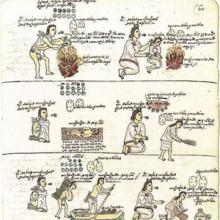Browse Primary Sources
Locate primary sources, including images, objects, media, and texts. Annotations by scholars contextualize sources.
Ethnic Minority Demonstrations in Bulgaria
Since the 1950s, the Bulgarian government conducted campaigns to assimilate Macedonians, Pomaks (ethnic Bulgarian converts to Islam), Gypsies, and Turkish Muslims by requiring them to substitute Slavic names for their own. The government also prohibited the use of the Turkish language in public and forbid Muslims from practicing their religious and traditional cultural activities.
Talking Points on the Malta Meeting
President George H. W. Bush held his first summit with Soviet President Mikhail Gorbachev early in December 1989 onboard a Soviet cruise ship docked off the coast of Malta.
President Bush Orders a Review of US Government International Broadcasting Activities
Following World War II, State Department officials, skeptical of the diplomatic value of programs they considered “propaganda,” persuaded Congress to cut allocations severely for Voice of America (VOA) radio programs that had been established during World War II to communicate US war aims to populations abroad.
The Future of Eastern Europe
By the spring of 1990, the future of the individual countries in Eastern Europe was still open for debate. While Poland, Czechoslovakia, and Hungary seemed to be transitioning toward Western-styled democracies, Romania and Yugoslavia, Bulgaria and Albania were following a different course.
Assessing the Future of the Soviet Military
Mikhail Gorbachev's reforms followed two paths: perestroika (restructuring) and glasnost' (openness). In order to reform the Soviet economy, Gorbachev believed it was necessary to cut spending on the Soviet military, both inside Soviet borders and throughout Eastern Europe.
State Department Views on European Security Prior to the 1990 Washington Summit
President George H. W. Bush and Soviet leader Mikhail Gorbachev met for a four-day summit, their second together, in Washington and Camp David beginning on May 31, 1990. Discord had grown dramatically within the Soviet government concerning the drastic changes that had occurred in the Soviet bloc during the previous year.

Gender Roles among the Nahua in the Codex Mendoza
From the time of birth, children in Aztec, or Nahua, society were socialized into gender roles. In the birth ritual introducing the infant to society, symbolic objects clearly differentiated. Boys were to be warriors and craftsmen, and girls were to tend to domestic chores. Articles of clothing—loincloth and cape for the boy, shift and skirt for the girl—were given to the child.
U.S. Reaction to Armenian Earthquake
On 7 December 1988, an earthquake with a 6.9 magnitude struck the Soviet Republic of Armenia. With powerful aftershocks continuing for months following, Armenia struggled to recover. By United Nations' estimates, more than 25,000 people were killed, 15,000 more injured, and the physical damage equaled $14.2 billion (U.S.).
U.S. Reaction to the Chernobyl Explosion
On April 26, 1986, an explosion at the Chernobyl Nuclear Power Plant in Ukraine led to the radioactive contamination of the surrounding countryside and to radioactive fallout throughout Eastern and Western Europe.
Soviets Discuss Perestroika for Other Communist Countries
In this letter to Mikhail Gorbachev dated October 6, 1988, Georgy Shakhnazarov, Gorbachev's adviser and a champion of reform in the Soviet Union, revealed his views about the urgency of perestroika (reform) in socialist countries worldwide.
Further Discussions on the Roundtable Talks
Prior to the historic roundtable talks between Polish Communist officials and leaders of the opposition that eventually took place from February to April 1989, Solidarity activist Andrzej Stelmachowski secretly met with Secretary Jozef Czyrek, a member of the Polish Politburo.
Report on the progress of the Roundtable Talks
Andrzej Stelmachowski, a Solidarity activist, engaged in secret negotiations between the opposition and communist party and state leaders in Poland regarding the preparations for the historic Roundtable Talks that eventually took place in February through April 1989.
Lech Walesa's Plans for the Roundtable Talks
In September 1988, Lech Walesa, leader of Poland's Solidarity Movement and later president of Poland following the collapse of communism (1990-1995), wrote this document a few months prior to the historic Roundtable Talks between party and state officials and the opposition that eventually took place in February to April 1989.
Debating the Participation in the Roundtable Talks
Prior to the historic Roundtable Talks between the opposition and the communist party and state officials in Poland, negotiations occurred on many levels, as shown in this document. Not only were participants in the opposition negotiating with communist leaders, but they were also negotiating among themselves.
Arms Reductions and the Warsaw Pact
The Warsaw Pact was based around the principle of cooperation and mutual assistance for its member states, though primarily it was a military alliance led by the Soviet Union. Therefore, Mikhail Gorbachev's arms reduction plan affected all of the member states of the Warsaw Pact by reducing all of the men under arms in Eastern Europe.
Religious Freedom in the Soviet Union
By the summer of 1988, Mikhail Gorbachev's reform policies glasnost' (openness) and perestroika (restructuring) had begun to change the political landscape of the Soviet Union. The U.S. and Soviet Union had made considerable progress in limiting arms build-up through a series of negotiations.
Report on the future of the Soviet Military in Eastern Europe
In May 1988, Georgi Shakhnazarov, an adviser to Mikhail Gorbachev and a champion of reform in the Soviet Union, responded to a report by Marshal Viktor G. Kulikov, the commander-in-chief of Warsaw Pact forces.
Soviet Policy toward Eastern Europe under Gorbachev
The Central Intelligence Agency (CIA) in the United States was closely watching the events unfolding in Eastern Europe and the Soviet Union in the 1980s, and this secret service document reveals the extent of that interest.
Gorbachev Discusses the Impact of Western Goods in the Eastern Bloc
At a March 10, 1988, Politburo meeting, Mikhail Gorbachev (leader of the Soviet Union) delineated his concerns about the growing influence of Western goods on Eastern bloc countries.

Food
The material culture of early childhood in the 21st century is characterized by an emphasis on biological age and related levels of cognitive and motor skill development. All types of objects, including diapers, toys, food products, and clothing, are divided into categories based on the age-appropriateness of a particular object.